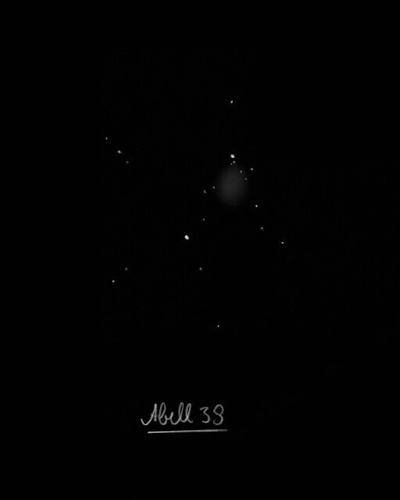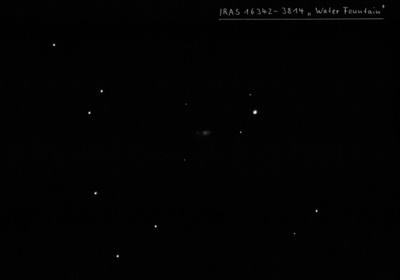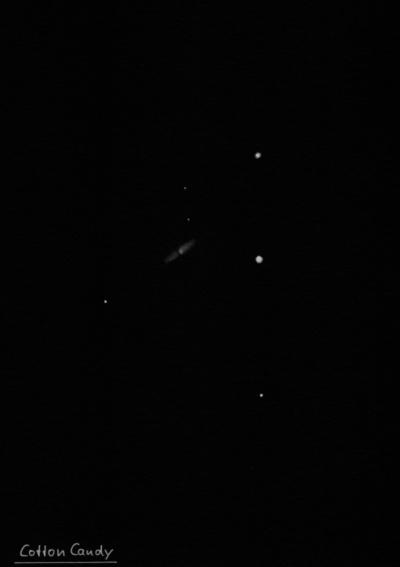A very prominent constellation of the southern sky's zodiacal constellation, stretching between Sagittarius and Libra. In our latitudes, it cannot be seen in its entirety, as part of the tail does not extend above the horizon. Scorpio peaks in our country at midnight in early June. The entire constellation can be well observed from about 40 degrees north latitude and south. Scorpio is one of the few constellations whose actual shape resembles the creature it is also meant to represent. The bright stars render the body, the dangerously curved tail dipped in the clouds of the Milky Way, and the outstretched claws once "robbed" by the stars of Libra (Libra was once part of Scorpio, as documented by the names of its brighter stars). The heart is represented by the red Antares, which Sagittarius points its bow at in the sky.
The star pattern of Scorpio is not the work of mere coincidence. In fact, most of the constellation's bright stars belong to the vast Scorpio-Centaurus association, a movement group that also includes many of the bright stars of the Wolf or Southern Cross. Antares is the most evolved known member of this vast OB stellar association. The other members are mostly main sequence stars B0, B1, B2, B3, giants and supergiants There are also several bright and dim nebulae around Antares, which lie roughly on the northeastern boundary of this association. A number of globular clusters can also be observed in the constellation, as most globular clusters are concentrated towards the centre of the Galaxy. However, the most beautiful object in the constellation is the open cluster NGC 6231.
Scorpius is located in one of the richest and most visually beautiful stellar regions of the Milky Way. Viewing the constellation in binocular is worthwhile and a feast for the eyes in the form of clouds of stars, clusters and glowing nebulae. In its southern part, a prominent concentrated, central brightening spot is visible to the naked eye above G Scorpii, which is actually the very striking open cluster M7 (3.3mag). It represents one of the brightest spots in the Milky Way ever. Slightly to the north of it is another cluster, M6, which is smaller and less concentrated, looking more like a blurred star. More visually interesting, however, is the surroundings of the open cluster NGC 6231, which lies in a magnificent field of bright stars often called the False Comet.
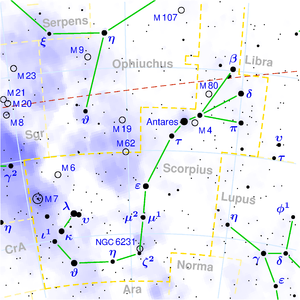
Antares (α Sco) - In ancient times, people saw a competitor in this star, the counterpart of Mars (anti-Ares: against Mars), as the strikingly red star strongly resembles the "Red Planet". The old Arabic name Kal al Akrab is no longer used, but the Latin designation Cor Scorpion - Heart of the Scorpion is derived from it. It lies at the intersection of the extended lines connecting the lateral sides of the Hercules quadrilateral. A greenish-colored physical companion with a brightness of 5.4 mag can be found at a separation of 2.9" best with a 200mm or larger telescope, as the glare of the main star is obstructive. A minimum magnification of 250x is recommended for visual resolution. The main component orbits approximately every 555 years.
Graffias (β Sco) - It is a binary star with components of 2.6 mag and 4.9 mag, separated by 13.6". The primary component is pale blue, the companion is dark blue, but there is no relationship between them. However, the brighter component itself is a close binary star that is not easy to distinguish even in a larger telescope.
σ Sco - The variable star, whose brightness varies between 3mag and 3.8mag in a period of 0.247 days, is also a binary star. The companion, with a magnitude of 9mag, is located at a separation of 20".
μ Sco - A binary star easily distinguishable with the naked eye. The brightness components of 3.1mag and 3.6mag are located at a distance of 8'. The brighter one is an eclipsing binary, whose brightness varies in the range of 34 hours between 2.9 and 3.2mag.
ζ Sco - Wide visual pair of unrelated stars distinguishable even with the naked eye. It consists of the blue-white giant ζ1, which is the brightest member (4.7mag) of the beautiful open star cluster NGC 6231. ζ2 is a red giant with a magnitude of 3.6, which is located much closer to us - 132 light-years away.
ω Sco - An optical binary star visible to the naked eye, composed of stars with magnitudes 3.9 and 4.3. One is located 470 light-years away from us and the other is 290 light-years away.
ν Sco - With a small telescope, we can distinguish two optical components with a brightness of 4.3 mag and 6.4 mag at a separation of 44". The main star is already a true binary star, with a companion of 6.8 mag located at a separation of only 0.9". The companion of the second star, with a brightness of 7.8 mag, is located at a separation of 2.3" and is within the reach of an 80 mm telescope.
ξ Sco - nice double star, with components of brightness 4.8mag and 7.3mag (bluish) at a separation of 7.6". The primary star is also a double star, currently not observable with a small telescope. The second component is almost equally bright (5.1mag) and is located at a separation of only 0.5". It has a yellow color. In the same field of view, there is also Struve 1999, a dark yellow pair of components with magnitudes 7.4mag and 8.1mag, at a separation of 11.6".
NGC 6231
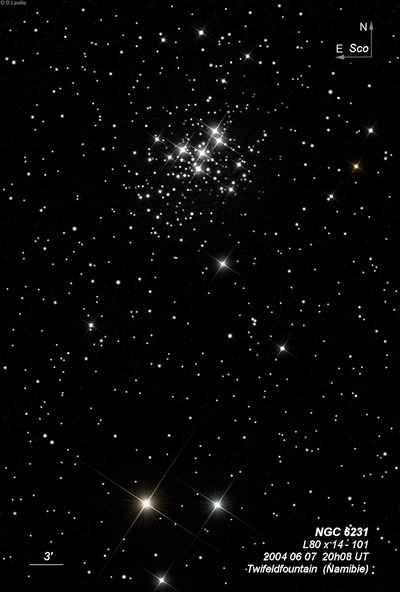
Giovanni Hodierna discovered NGC 6231 = Lac II-13 = D 499 = h3652 around 1650 from Sicily. Edmond Halley independently discovered the cluster in 1677 whle cataloging southern stars from the island of St. Helena. Discovery credit is often given to Nicholas-Louis de Lacaille, who observed it in 1751-1752 with a 1/2" telescope at 8x during his expedition to the Cape of Good Hope. He noted a "close group of seven or eight close faint stars". James Dunlop described "a cluster of pretty bright stars of mixt small magnitudes, considerably congregated to the centre, about 10' diameter, with a large branch of very small stars extended on the north side; this is 150 Scorpii." John Herschel wrote, "a fine bright, large cluster; pretty rich; class VII; 10'; stars 10...13 mag. Place of a double star 5m, the preceding but one of 7 bright stars in the middle."
Ashworth argues in the "Journal for the History of Astronomy" (1981) that Ptolemy listed NGC 6231 in his catalogue as a star (14 Scopii), though did not observe it as nebulous. It was included as a star or nebula, in every major catalogue and atlas since, but it's position and different labels were so inconsistent that it was not recognized as the same object found by Lacaille in 1752. For example, it was listed as Bayer's southern Mu, and Sharp's Zeta. It was depicted as the southern of a pair of stars in Bayer's atlas and the northern in Hevelius' atlas.
200/250mm - 8" (7/13/91 - Southern Baja): over 100 stars mag 8-12. Bright, very large, scattered. Divided into two main groups and fills the 40' field. Emission nebula IC 4628 is involved on the north side (seen from Baja) and a trail of stars extends towards NGC 6231.
8" (6/27/81): bright, large, scattered cluster in two main groups.
8" (7/13/91 - Southern Baja): bright group of stars in center like jewels over rich sprays of stars, excellent low power field. Located 30' N of Zeta Scorpii. Partially resolved in 8x50 finder.
8" (6/27/81): impressive cluster at 100x with a bright group of 8 stars in the center. Partially resolved in the 8x50 finder.
300/350mm - 13.1" (7/5/83): five bright stars are in the cluster with a dozen stars in the central portion and 50 stars in a 20' field. There is a 1° field to the NW and NE consisting of fairly bright stars = NGC 6227 and Tr 24 = H12.
400/500mm - 17.5" (7/4/86): 100 stars at 84x in the main part including 10 bright stars. Impressive cluster at low power.
Naked-eye - (numerous times): this is an easy naked eye cluster, even from northern California, looking like a comet heading north from Zeta Scorpii. From further south (southern Baja or southern Hemisphere), it is a very prominent naked-eye cluster.
Notes by Steve Gottlieb
M 7
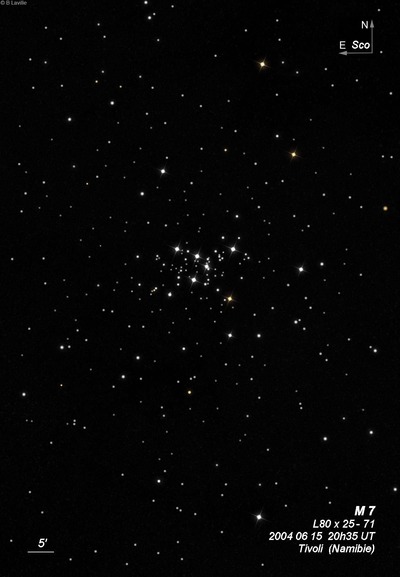
Giovanni Hodierna made the first telescopic observation of M7 = NGC 6475 = Lac II-14 = h3710 in 1654 and resolved the cluster into at least 30 stars. Edmond Halley made an early observation of M7 in 1677 from St. Helena while cataloging southern stars and Nicolas-Louis de Lacaille "discovered" it again on 15 Jun 1752 from the Cape of Good Hope, as he unaware of Hodierna's earlier observation. At a declination of -34.7°, M7 culminates only 7° above the horizon from Paris, so Messier's confirmation on 23 May 1764 is impressive. Halley was credited with the discovery in the NGC.
M7 is often referred to as "Ptolemy's Cluster" as it was possibly included in the Almagest as a "nebula following the sting of Scorpius." (found ~138 BC). But David Frew states that G Scorpii is the object described as nebulous as Ptolemy may have accidentally precessed the position of G Scorpii in Hipparchus' catalogue.
200/250mm - 8" overfills 40' field, not many faint stars, scattered.
300/350mm - 13.1" very bright, very large, impressive but scattered, overfills 52' field. Open cluster H18 lies 45' SE and globular cluster NGC 6453 40' WNW of center. Prominent naked-eye cluster in dark sky. Includes several blue-white and yellowish stars.
400/500mm - 18" (7/21/04): at 92x at least 300 stars are visible in the cluster, though very difficult to count due to the very large size (overfills the 42' field). The more concentrated part of the cluster spans perhaps 30' and includes a dozen stars of mag 7.5 or brighter in the main body. This cluster is much larger and brighter (very prominent naked-eye), but it is much more scattered than M6 and so is less impressive. There are several bright, distinctive strings in the cluster including a N-S string of ~8 stars on the east side of the central region. An equilateral triangle of mag 6, 7 and 8 stars with sides of 3' is on the NW side of the core of the cluster. A clump of 5 stars is near the center including two mag 6 and 7 stars. On the south side of the center of the cluster is an 11' string of 5 mag 5.6 to 7.8 stars oriented SW-NE with the bright mag 5.6 star (HD 16258) on the SW end a distinctive yellow color.
Notes by Steve Gottlieb
M 4
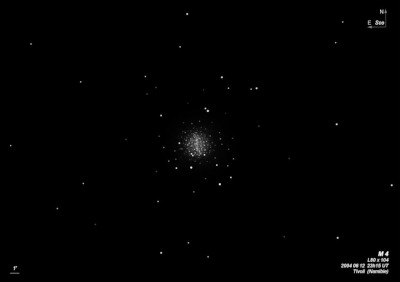
Philippe de Chéseaux discovered M4 = NGC 6121 = Lac I-9 in 1745-46. Nicolas-Louis de Lacaille found it again in 1751-1752 with a 1/2" telescope at 8x during his expedition to the Cape of Good Hope. William Herschel didn't catalogue M4 as he tried to avoid repeating the Messier objects but described M4 as "a rich cluster of considerably compressed small stars surrounded by many straggling ones. It contains a ridge of stars running through the middle from south preceding to north following. The ridge contains 8 or 10 pretty bright stars. All the stars are red." He noted in his 1814 publication that the observed red color was probably owing to the low elevation of M4, though there is one conspicuous red star in the bar. John Herschel has no entry in his Cape of Good Hope catalogue, though he undoubtedly observed this showpiece.
200/250mm - 8" (6/19/82): superb resolution of mag 11-13 stars.
300/350mm - 13.1" (6/19/82): the core is beautifully resolved including the bar which resolves into a number of faint stars. The halo is fully resolved with many star lanes.
400/500mm - 17.5" (7/4/86): very bright, very large, 15' diameter. Resolved into an extremely dense swarm of several hundred stars with many stars arranged in strings. Appears fully resolved at moderate power including the distinctive bar extending N-S through the center. M4 is possibly the closest GC at a distance of 5600 light-years.
600/800mm - 24" (8/16/12): M4 displayed several orange/red supergiants, including the brightest star (mag 12) within the central bar. This star is situated at the northern intersection point of the bar and the partial oval ring of stars that extends mostly to the east of the bar. Another orange star is on the southwest side of the core, 4' from center. A bright, orange mag 10 star is on the SSW side of the halo, 6.5' from center. A wide, bright pair of orange stars (10.8/10.9 at 17") is SE of the bar (1.8' from center).
Notes by Steve Gottlieb
M 6
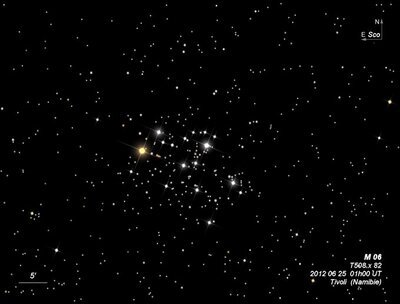
Giovanni Hodierna discovered M6 = NGC 6405 = Lac III-12 = h3699 before 1654 and recorded 18 stars. De Chéseaux independently found the cluster in 1745-46. Nicolas-Louis de Lacaille found the cluster again in 1752 with a 0.5-inch telescope at 8x, during his expedition to the Cape of Good Hope, and found a "remarkable group of faint stars in parallel lines making a diamond 20-25 minutes diameter filled with nebulosity." Lacaille is credited with the discovery in the NGC. James Dunlop's D 612 may refer to M6 as his position falls on the east side of the cluster, though D 612 could apply to NGC 6416, given his often poor positions. Although a naked-eye cluster, it apparently was not included in any earlier list.
In his Messier survey, WH logged on 30 Jul 1783 "I counted about 50 stars; it contains the greatest variety of magnitudes of any nebula I recollect. The compound eye-piece shows more of them variously and intermixed."
According to Sue French, the popular nickname "Butterfly Cluster" may come from "Splendour of the Heavens" (1923), as M6 is described as "somewhat irregular in shape, with central rib of stars, and resembles a butterfly with open wings."
300/350mm - 13.1" (7/5/83): very bright, fairly large. Includes a curving rows of stars and a close group of 7 stars near the center. The brightest star BM Scorpii is on the east side. Smaller than M7 but richer. Fairly easy naked-eye cluster.
400/500mm - 18" (7/21/04): at 92x roughly 200 stars are visible in this beautiful naked-eye cluster. There are four bright mag 6-7 stars in the main group which form a perfect parallelogram with longer sides of 7' oriented WSW-ENE and shorter sides of 4' oriented NW-SE. A string of stars connects the two stars on the long southern side of the parallelogram (the star at the SE vertex is orange-tinged BM Sco) with a nice double star embedded in the string. The NW vertex is part of a bright isosceles triangle with two mag 8-9 stars and ~7' further NW of this star is a small, nice asterism consisting of a trio and a double. Also a wedge-shaped group of 7 stars extends between this NW vertex (which also has two additional fainter companions) and the SW vertex (short side of parallelogram) Another distinctive string of stars runs through the center of the parallelogram roughly parallel to the two long sides. A nice mag 9/10 double resides along the long northern side of the parallelogram. An additional mag 7 star is the SW of the parallelogram. Around the main group there are numerous scattered stars and the cluster does not have a distinct border. Over 70 stars in the cluster are brighter than 11th magnitude.
Notes by Steve Gottlieb
M 80
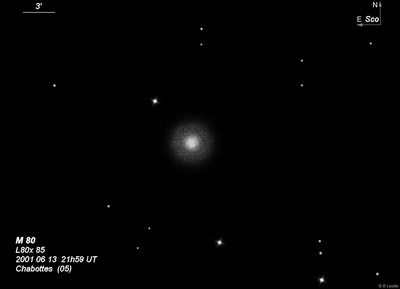
Charles Messier discovered M80 = NGC 6093 = h3624 on 4 Jan 1781. On 21 May 1784 (sweep 222), WH reported "a large cluster of exceedingly small and compressed stars, about 6 or 7' in dia; a great many of the stars are visible, the rest so small as to appear nebulous; those that are visible are of one size and are scattered all over equally. The cluster is of an iR form." On 24 May 1835 (sweep 588), John Herschel logged "Glob. Cl.; v m comp M; psvmbM; diam 12.0'; st = 14 m; all resolved. Fine object."
Arthur von Auwers discovered a nova (T Sco = Nova Scorpii 1860) in M80 on 21 May 1860 at Konigsberg Observatory. The magnitude was estimated between 6.5 and 7.0, as bright as the entire cluster. It was seen by N.R. Pogson on 28 May, while observing the variables R and S Sco, which share the same field. He reported being started by the appearance of a mag 7.6 star in the place of the cluster! Pogson assumed it was a new variable precisely along our line of sight to M80. T Sco is probably the first known variable star to be associated with a cluster.
200/250mm - 8" (7/5/83): a few faint stars resolved at moderate to high power at edges, very grainy, difficult to resolve.
300/350mm - 13" (7/5/83): contains a small intense unresolved core surrounded by fairly compact halo 5' diameter. The nucleus is offset to the east within the halo. The outer shell resolves into a few dozen faint stars over haze.
400/500mm - 17.5" (6/3/00): fairly bright, round, 5' diameter, well concentrated with a bright 1.5' core and an intense 30" nucleus. At 500x, the nucleus is clearly offset east of center and the outer halo is well resolved into at least 75 stars. A dim galaxy, IC 4596, lies 25' NW.
Notes by Steve Gottlieb
NGC 6302
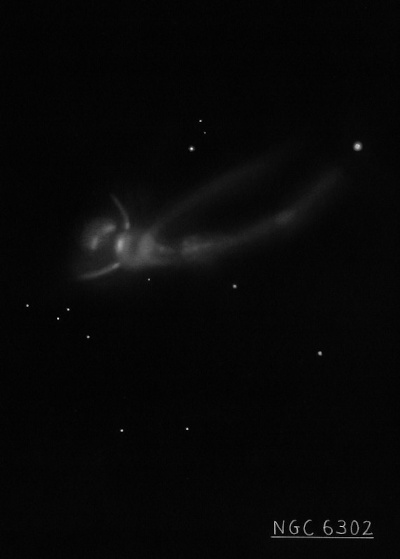
E.E. Barnard discovered NGC 6302 in 1880 with his 5-inch refractor. He wrote, "A small flickering indefinite nebula slightly elongated (east and west) with 5-inch refractor." This was the first nebula that Barnard found, though the discovery was not published until 1884 (AN 108, 369 and Sidereal Messenger, Vol 2, p226). He noted "Prof. Swift, with his 16 inch refractor finds it to be a triple and elongated; its major axis nearly perpendicular to the meridian; a smaller nebula at each end, one of which is exceedingly faint. Its place is from one observation with the meridian circle." In 1892 Barnard made a detailed observation and sketch with the 36-inch refractor at Lick Observatory. As far as the popular nickname, Barnard commented, "from its singular appearance, I have called it the "Bug Nebula".
Dreyer noted "seems to be Dunlop 567 [found on 5 Jun 1826]" in the IC 1 Notes. Dunlop's description reads "a very faint small ill-defined nebula, with a small star in it, with two small stars south of it, but not involved." If this description applies to NGC 6302, his position was particularly bad -- 1.1° NE of the planetary. But Glen Cozens, in a 2010 article in the "Journal of Astronomical History and Heritage" states "D 567 is an asterism, not the planetary nebula NGC 6302, as suggested by Hartung." It's surprising the John Herschel missed this bright planetary during his sweeps.
200/250mm - 8" (6/27/81): fairly bright, small, elongated, bright core and brighter along the western extension.
300/350mm - 13.1" (7/27/84): structure highly suspected with the western extension cut by a dark lane. The eastern extension bends north following the core.
13.1" (7/5/83): bright, fairly small, elongated E-W, very high surface brightness. Subtle structure but the western extension is notably longer, brighter and possibly cut by a dark lane.
400/500mm - 17.5" (6/30/00): at 280x (unfiltered) the Bug Nebula is a remarkable, high surface brightness object, elongated 3:1 WSW-ENE, ~2.0x0.7'. The intensely bright 10" core appears elongated SW-NE and is offset to the east of center. A quasi-stellar nucleus sharpens to a stellar point when the seeing steadies (this is not the central star, though). The western wing is longer and is nearly split at the midpoint by a dark slash oriented N-S with a brighter condensation at the west end. The shorter eastern wing is more pinched and just past its midpoint there is a kink and it angles towards the SE.
900/1200mm - 48" (5/3/19): amazing view of the Bug Nebula at 375x! The central section was elongated roughly N-S and displayed an extremely high surface brightness. Four distinct "wings" were attached; two to the west and two to the east. A surprisingly long wing is on the southwest side. It has a noticeable bright section after dimming. The wing tapers and then fades, stretching to the WNW for a total length of near 2'! A mag 12 star is ~30" NW of the end of the wing. The lowest surface brightness wing is on the NW side and extends in the direction of the mag 12 star for about 1' in length, but extends ~1.5' with averted vision. The third extension on the southeast side is the narrowest and tapers at the east end. It appeared fairly uniform in surface brightness. Finally, the 4th and brightest wing is on the northeast side. It extends towards the ENE but curls to the SE forming the shape of a "pincher claw" with the southeast wing.
Notes by Steve Gottlieb
NGC 6281
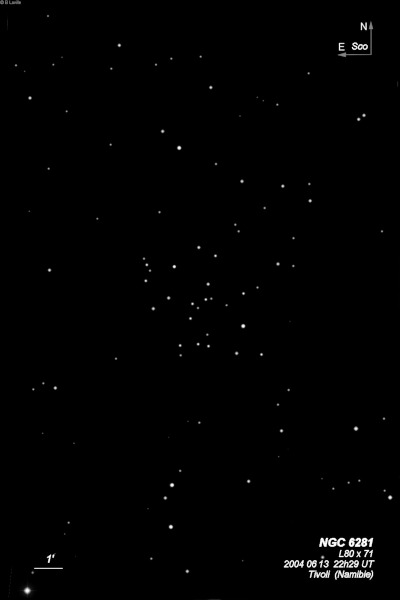
James Dunlop discovered NGC 6281 = D 556 = h3664 on 5 Jun 1826 and described "a curiously curved line of pretty bright small stars, with many very small stars mixt." Dunlop made 3 observations of the cluster and his position is 20' too far east. JH made a single observation on 28 Jun 1834 and recorded "a p rich, L, pB, cluster VII class, of loose stars 9, 10, 11th mag, which fills 2/3 of field." His position is on the double star HJ 4915 on the north side of the main group.
200/250mm - 8" (6/27/81): two dozen stars mag 9-11 in a distinct fairly bright, rectangular group of ~10' diameter.
400/500mm - 18" (6/12/10): this bright 10' diameter cluster was even resolved in my 80mm finder at 25x. Excellent in my 18" at 175x with roughly 50 resolved stars to mag 14 including two dozen brighter mag 9-10.5 stars in a distinctive, well-defined outline. Several double stars are involved including h4915 = 9/10.8 at 11" on the NE side and a 10" pair of mag 10.5/11.5 stars in the center. Several of the cluster's fainter stars are situated on the south side. A number of the brighter stars are in two strings forming a right angle. The northern line is oriented SW-NE and the southwest line is oriented NW-SE. The vertex is at the west end of these strings (NW edge of the cluster). NGC 6281 is located 2.5 degrees east of Mu1/2 Sco.
Notes by Steve Gottlieb
NGC 6383
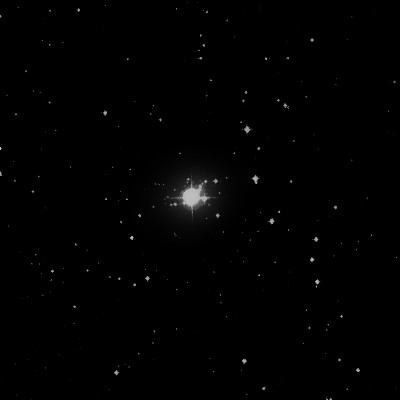
John Herschel discovered NGC 6383 = h3689 on 3 Aug 1834 and recorded "a curious cluster consisting of one large * 6-7m, and some 15 or 20 small ones 13m clustering close to it." His position is on the bright star. On a second sweep he reported "a star 7m with a cl of st 12m assembled about it. The great * occupies the centre. A very remarkable object." NGC 6374 is a duplicate observation, verified by his mention of the bright star.
200/250mm - 8" (6/27/81): Includes a mag 5.8 star and 12 faint stars, excellent with averted, brightest star appears triple. Surrounded by very large, very faint nebulosity.
400/500mm - 17.5" (8/27/92): 20 stars mag 12-14 surround mag 5.7 HD 159176. Elongated WNW-ESE in a 5' string. The bright star has 4 or 5 faint companions within 1' (h4962 = 5.7/10.5/10.5 at 5"/13"). Also just west is 20' scattered string of 20 stars including 8 mag 10-11 stars visible in the 80mm finder. This is a striking cluster.
Notes by Steve Gottlieb
NGC 6416
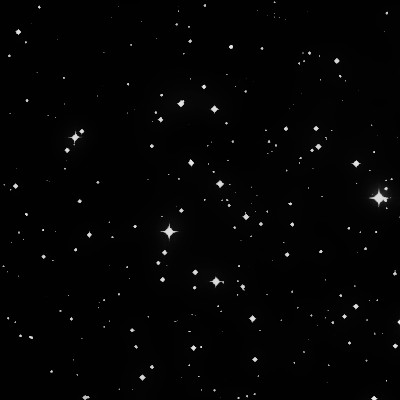
John Herschel discovered NGC 6416 = h3702 = D612? on 3 Aug 1834 and recorded "Cl class VIII of stars 11m; fills field; not rich; stars in zig-zag lines." His position is accurate. James Dunlop possibly discovered the cluster earlier on 13 May 1826 and described "a cluster of small stars of mixt magnitudes, about 15' diameter, irregular figure." His position, though, is nearly 40' west of the cluster and actually falls on the east side of M6, 13' from the center. So, his identification is uncertain though seems to describe NGC 6416 better.
200/250mm - 8" (6/19/82): almost two dozen faint stars, large, scattered, not impressive as fairly coarse.
400/500mm - 17.5" (8/2/97): best view at 100x as it fills the 220x (9mm Nagler) field. The most detached portion consists of a large cloud of at least 15' diameter and containing roughly 75 stars. There are four brighter stars (including mag 8.6 SAO 209208) but most of the stars are pretty uniform in brightness and fairly evenly distributed at 100x. The cluster may extend further north than the region described above but the star density quickly decreases to the general Milky Way appearance.
Notes by Steve Gottlieb
NGC 6124
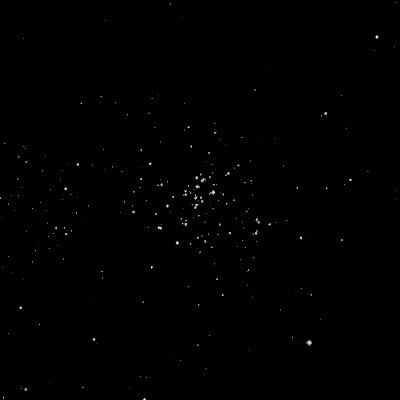
16x80mm (6/18/85): this bright cluster appears partially resolved even in my 16x80 finder.
Nicolas-Louis de Lacaille discovered NGC 6124 = Lac I-8 = D 514 = h3626 in 1751-1752 with a 1/2" telescope at 8x. During his expedition to the Cape of Good Hope he catalogued "a fairly big tailless comet." James Dunlop observed it on 10 May 1826 as "a round cluster of small stars of nearly equal magnitudes, about 12' diameter, considerably congregated to the centre, not rich in small stars. This answers to the place of 44 Normae, but there is no nebula." Dunlop made a total of 5 observations and his position is accurate.
On 5 Jun 1834 (sweep 456), John Herschel logged "Viewed; a brilliant cluster class VII.; p rich, L, irregularly scattered, fills field, stars 8,9,10,11th mag." On 4 Aug 1834 he recorded the cluster as "cluster, bright, large, loosely scattered, not much compressed in the middle, fills nearly a field, consists of about 50 or 60 stars 9..11th mag."
200/250mm - 8" (6/27/81): fairly large but scattered, richer in center.
300/350mm - 13.1" (6/18/85): bright, fairly rich, large, roughly 125 stars are resolved.
600/800mm - 25" (4/5/19 - OzSky): gorgeous open cluster at 102x (31mm Nagler) and 244x (13mm Ethos). with several hundred resolved stars within a 25' field. Contains a very large number (perhaps 30) of 9th and 10th magnitude stars. There is a condensed group of roughly 3 dozen stars in the center, many forming easy but eye-catching pairs. The central stars are distributed irregularly with a nearly vacant lane running roughly NW to SE. The "halo" stars are spread out fairly evenly and a roughly circular outline of ~25'. Two 10" pairs forming a wide "double-double" is close east of the central group.
Notes by Steve Gottlieb
NGC 6242
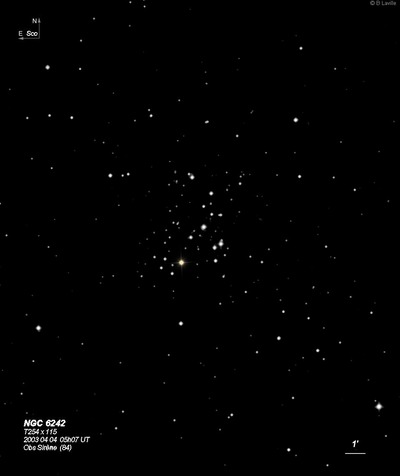
Nicolas-Louis de Lacaille discovered NGC 6242 = Lac I-10 = D 520 = h3654 in 1751-1752 with a 1/2" telescope at 8x, during his expedition to the Cape of Good Hope. He simply noted an "elongated faint oval spot." James Dunlop observed the cluster on 13 May 1826 with his 9-inch f/12 reflector and recorded "a cluster or group of small stars, about 4' diameter, with branches extending S.p. and N.f., with considerable compression of the stars towards the centre of the group. This answers to the place of 155 Scorpii, but there is no nebula." He made 3 observations and his position is 4'-5' west of center of the cluster.
John Herschel first observed the cluster from the CGH on 5 June 1834 and logged "a p rich brilliant cluster of stars 10...12th mag, with one 7-8th mag near middle." Later in month (28 Jun) he recorded "cluster VI class, B, L, rich, discrete, 12', irregular figure, vlbM, fine object; place of a red star 9th mag, rest 11th mag, white." The next night he logged it as "a fine large rich cluster, class VII, stars 9..12th mag, fills field, place of a red star 8-9th mag in centre."
200/250mm - 8" (6/27/81): two dozen stars mag 8-11, fairly rich, compact, nice at low power. Faint stars are visible with averted vision.
400/500mm - 17.5" (7/16/93): ~100 stars in a 10' region at 220x, rich in faint stars. Includes red mag 7.3 SAO 101654 in the SE corner of cluster and 8 brighter mag 10-11 stars. Includes several curving arcs of stars with a few dozen mag 13 stars and a rich background carpet of mag 14.5-15.5 stars.
Notes by Steve Gottlieb
NGC 6388
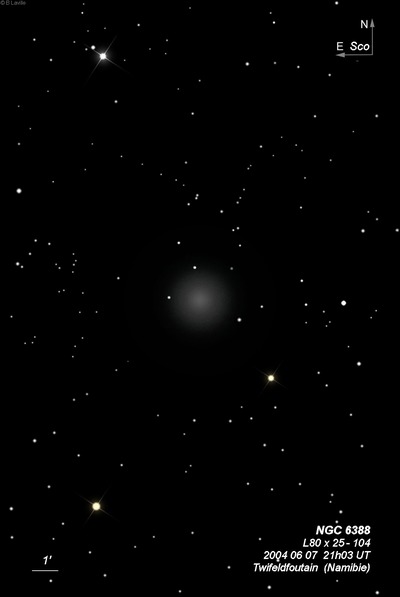
James Dunlop discovered NGC 6388 = D 457 = h3690 on 13 May 1826 and described "a beautiful round nebula, about 5' diameter, with a bright round well-defined disk or nucleus, about 15" diameter, exactly in the centre; this has the appearance of a planet surrounded by an extremely faint diluted atmosphere; there is a small star involved in the faint atmosphere: the atmosphere is at least 6' diameter - Figure 18." His position is just 1.5' south of center.
John Herschel, observing on 5 Jun 1834, recorded "globular, vB, R, at first pg, then psvmbM to an intense almost nuclear light. The right eye does not resolve or barely makes it resolvable; the left resolves it completely into stars 17...20m. A superb object on a rich ground of milky way." On 1 Jul 1834 he logged "globular, vB, R, first p g, then psvmbM, 4' diam, easily resolved with left eye into stars 17m, more difficulty with right eye into 18m, excessively close and comp; shading off insensibly in borders into the general ground of the heavens."
200/250mm - 8" (6/19/82): bright, moderately large, intense core, fainter halo, no resolution.
300/350mm - 13.1" (7/12/86): bright at 214x, moderately large, increases to a small very bright core. Has a grainy, lively appearance but no resolution. Elevation at most 7°.
400/500mm - 18" (7/8/02 - Magellan Observatory, Australia): at 171x, this bright globular appears moderately large, round and granular but with no definite resolution within the main halo. The appearance was very symmetric and strongly concentrated with a blazing core that ranks as one of the highest surface brightness globular cluster cores. I didn't use higher power to try and resolve.
Notes by Steve Gottlieb
NGC 6441
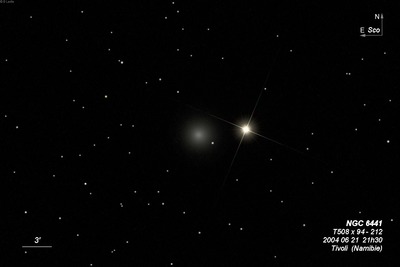
80mm finder (7/14/99): the globular was easily visible at 21x in the finder.
James Dunlop discovered NGC 6441 = D 557 = h3705 on 13 May 1826 with his 9-inch f/12 reflector at Paramatta. He described "a small well-defined rather bright nebula, about 20 arcseconds diameter, a very small star precedes it, but it is not involved; following gamma Telescopii." He observed this globular on 5 nights and his position is just 2' south of center (unusually accurate for him).
John Herschel first recorded on 28 Jun 1834, "globular cluster, B, R, 90", vgbM, resolvable (barely so), a very regularly graduating neb or cluster; in field with gamma Telescopii." The next night he logged "globular, B, R, vgbM, up to a blaze. In field with Gamma Telescopii, and nearly on the same parallel; with left eye I barely see it resolved into stars 18 or 20m. The whole ground of the heavens, for an immense extent, is thickly sown with such stars. A beautiful object." Christian Peters claimed he discovered it around 1850, while at the Capodimonte Observatory in Naples (AJ 2, 1856).
200/250mm - 8" (5/21/82): bright, intense core.
300/350mm - 13" (6/18/85): very bright core, mottled halo but no certain resolution. Located just 4.5' E of G Scorpii (V = 3.2), which hampers viewing.
400/500mm - 17.5" (7/14/99): NGC 6441 is situated just 4.5' following mag 3.2 G Scorpii! At 220x it appeared moderately bright, round, ~2.7' diameter, fairly sharp concentration with a prominent 1' core. A mag 11 field star is at the southwest edge of the halo (1.3' SW of center), a mag 13.5 star is just inside the west edge of the halo (1.2' from center), and a mag 12.5-13 star is just off the northwest side. There was no definite resolution into cleanly visible stars, although the globular had a granular appearance. H 1-36, a symbiotic star (mimics a stellar planetary), is located just 1.3' NW of the mag 3.2 star!
Notes by Steve Gottlieb
NGC 6259
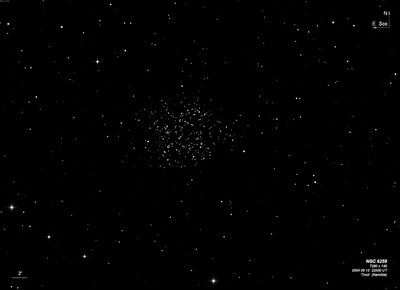
James Dunlop discovered NGC 6259 = D 456 = h3660 on 13 May 1826 and described "a very large patch of strong nebula, about 20' long, and 16' broad, rich in small and extremely minute stars." His position (only to the nearest minute of time in RA) was 11' too far southeast. On 1 Jun 1834, JH called it "a superb, vL, v rich cluster, which fills field; R, vglbM, stars 11..12th mag, thickly sown at intervals from each other from 10" to 20"." On a second sweep he described it as "vL, v rich, fills more than a field, has one or two straggling appendages p and s; stars 11 and 12th mag, nearly equal." JH also found the cluster on 3 Jun 1834 but made a 10 minute transcription error in RA. As a result, h3650 = NGC 6222 is a duplicate observation.
200/250mm - 8" (7/16/82): 12 faint stars mag 11-12.5, over unresolved haze, elongated N-S. Appears to be rich but observed at a very low altitude which diminished the view.
400/500mm - 18" (7/9/02 - Magellan Observatory, Australia): at 128x this cluster appears as a beautifully rich cloud of stars. A couple of hundred stars are resolved in an 8' diameter. Fairly uniform in density and magnitude and roughly circular (similar to NGC 7789). This very rich cluster would be a showpiece for U.S. observers if further north! NGC 6249 lies 33' SW.
Notes by Steve Gottlieb
NGC 6451
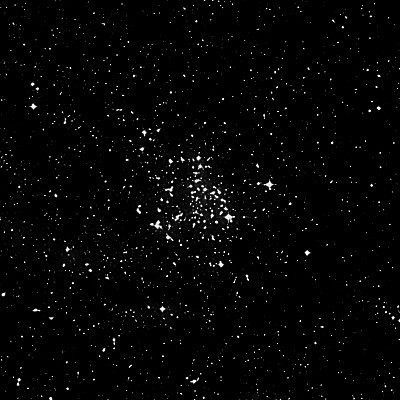
William Herschel discovered NGC 6451 = H VI-13 = h3707 on 24 Jun 1784 (sweep 232) and recorded "a cluster of small and pretty compressed stars of several magnitudes; about 5 or 6' in diam, not very rich." On 3 Aug 1834 (sweep 478), John Herschel logged "a remarkable cluster; divided into two by a broad, vacant, straight band; irreg R; 8' diam; st 12...15m. See fig 5, Pl V." His sketch shows two elongated groups of stars separated by a starless lane.
200/250mm - 8" (6/27/81): faint but rich group.
300/350mm - 13.1" (6/18/85): about three dozen stars in a 8' diameter. The brighter stars around the edges form the outline. Includes many very faint stars inside the bright border but unconcentrated towards the center.
Notes by Steve Gottlieb
NGC 6192
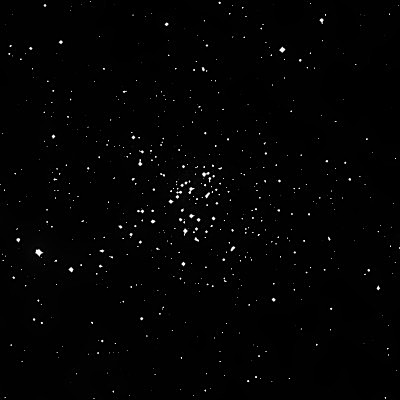
James Dunlop discovered NGC 6192 = D 483 = h3641 on 13 May 1826 and recorded "a cluster of very minute stars, of a round figure, about 4' diameter, following v Normae." He made 3 observations and his position is less than 4' north of center of the cluster. D 470 is probably a duplicate observation but his position is 19' too far east.
On 1 Jun 1834, JH logged "Cluster VII, pretty rich, irr R, gbM, 10', stars 12..14th mag, a straggling group." Two nights later, he called it "a coarse but rich cluster of stars 11.12th mag, which leaves dark lines unoccupied, forming sections (see fig 4, Plate V)." The central section in his sketch shows 4 circular wedges separated by dark lanes.
200/250mm - 8" (6/19/82): 20 faint stars mag 11-12.5 over unresolved haze, small, fairly rich with averted. Easy to identify in the field, though very far south for viewing from Northern California.
Notes by Steve Gottlieb
NGC 6496
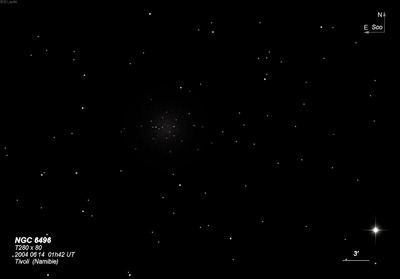
James Dunlop discovered NGC 6496 = D 460 = h3715 on 28 Jun 1826 and described "a very faint nebula, extended about 2 1/4' in length, oblique to the equator, with a bright point in each extremity; the northern, I think, is a very small star; but the southern of the two, or the one at the southern extremity, is a small nucleus or condensation of the nebulous matter. This follows 16 Telescopii - Figure 19." His position is 12.5' northwest of the cluster -- a typical error. His sketch shows the globular elongated NW-SE, which is probably due to several brighter stars. Dunlop's position for D 461 is 4 minutes of RA further east and same declination, so this could be a clerical error.
John Herschel noted a possible equivalence with D 460 and D 461 and observed the cluster on two sweeps. On 1 Jun 1834 he logged "Cluster very rich, irregularly round, including to triangular; vglbM, 4' or 5' diam, with many large and small stars in it. Nebulous." Then 2 nights later he swept the area again and reported "a distinctly nebulous insulted group, mE, 2' long, 1.5' broad, many stars of considerable size, mixed."
200/250mm - 8" (6/19/82): faint, diffuse, two faint stars at edge. Located 24' ENE of mag 4.9 SAO 228562 on the Scorpius-Corona Australis border. This cluster is very far south (low elevation) from Northern California.
400/500mm - 18" (7/10/02 - Magellan Observatory, Australia): moderately bright, low surface brightness globular of 4'-5' diameter. The globular has a loose concentration class with only a little central condensation. About a dozen stars were resolved over the face although some of these may be superimposed foreground stars as the cluster is set in a very dense Milky Way star field. Three of the stars are 12th magnitude with the remainder mag 14-15. The globular straddles the Scorpius/Corona Australis border, ~25' following mag 4.8 yellow HD 163145.
Notes by Steve Gottlieb
NGC 6144
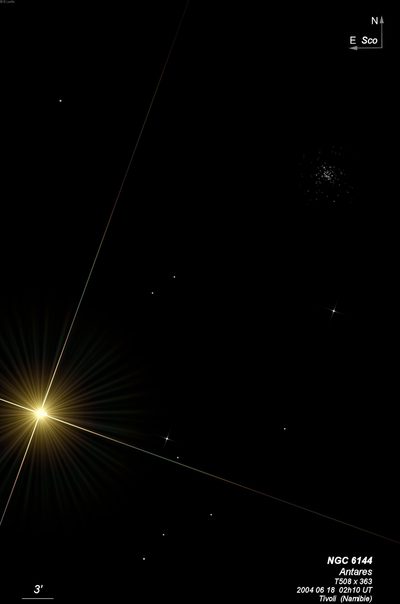
200/250mm - 8" (6/27/81): faint, small. A mag 12 star is at the SW end but no other resolution. Located 40' NW of Antares.
300/350mm - 13.1" (6/18/85): a dozen very faint stars are resolved at 220x over haze. Includes a string of stars to the SE.
13.1" (6/19/82): just resolves in steady moments into perhaps 15 very faint stars over haze. Otherwise the globular is very lively and mottled.
400/500mm - 17.5" (6/6/86): about 20 stars mag 12-14 resolved at 286x. The brightest mag 12 star is at the west edge. Located 37' NW of Antares. This globular is about 30,000 light years away or 5 times the distance of nearby M4.
Notes by Steve Gottlieb
NGC 6139

James Dunlop discovered NGC 6139 = D 536 on 13 May 1826 and recorded "a round nebula, about 1' diameter, bright immediately at the centre, and very faint from the bright nucleus to the margin. Another observation makes the figure rather elliptical, with a bright nucleus." He observed the cluster twice and his position is pretty poor -- 23' east of center.
John Herschel acknowledged Dunlop's discovery despite the poor position and observed the globular on 4 nights. On his first sweep of 24 Jun 1834 he logged "vB, R, pL, pgmbM, 2.5'. Evidently a globular, but moonlight very bright and near full, and I cannot see the individual stars." Two nights later he wrote "B, R, pgbM, resolvable, 2'." Another two nights later he wrote "pB, R, pgbM, resolvable, with left eye I can barely discern a few of the stars." Using the Great Melbourne Telescope on 2 Jun 1877, Joseph Turner called it "very finely stippled but too faint for any stars to be seen distinctly" (p. 137 in logbook).
200/250mm - 8" (6/27/81): faint, small, even concentration to core. Although easily visible, there was no resolution.
400/500mm - 18" (7/10/02 - Magellan Observatory, Australia): this globular appeared moderately bright and well concentrated to a bright 1' core. The halo spanned ~3.5' and the overall structure was symmetric. A number of very faint stars winked in and out of view with the seeing and the cluster appeared on the verge of extensive resolution at 171x. I didn't examine it, though, at higher power.
Notes by Steve Gottlieb
NGC 6453
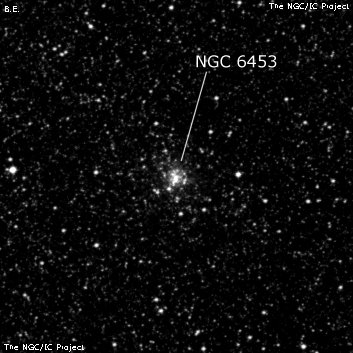
John Herschel discovered NGC 6453 = h3708 on 8 Jun 1837 and recorded "a highly condensed nebulous mass, 3' diam, or an irreg R neb; pmbM; resolvable." His RA was 28 seconds too large, but it was reported as rounded to the nearest minute (marked as +/-) and the description fits.
200/250mm - 8" faint, small, diffuse. Located NW of M7 in the field.
400/500mm - 17.5" (7/4/86): at 220x appears very faint, small, very mottled. A few stars are resolved at the edges (possibly foreground stars). Located beyond the NW edge of M7 about 40' from the center. Open cluster NGC 6444 lies 20' SW.
Notes by Steve Gottlieb
NGC 6153
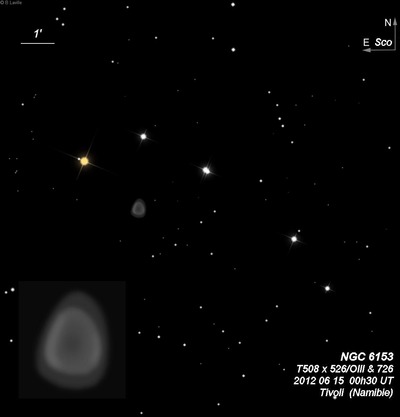
Ralph Copeland discovered NGC 6153 on 27 May 1883 near Lake Titicaca, using a 6.1" refractor with a direct vision Vogel-spectroscope. The position given in Copernicus III (1884) is just 1' too far north. In 1926, Willem van den Bos at the Cape Observatory, reported "This object is a planetary as seen through the 26 1/2-inch reractor. Major axis 28", Minor axis 22" in PA 7°-187°." The same year, W.S. Finsen called it a ring nebula.
300/350mm - 13.1" (6/18/85): fairly bright, fairly small, almost round, picked up at 62x. Striking location as forms the southern vertex of a small "kite" or cruciform asterism (rhombus) with two mag 10 stars 2.6' N and 2.7' NW and a mag 9.5 star 2.5' NE. Although prominent, this planetary is very far south for viewing from northern California.
Notes by Steve Gottlieb
NGC 6072
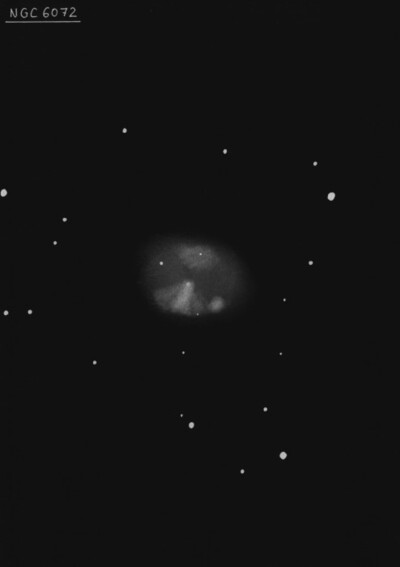
John Herschel discovered NGC 6072 = h3620 on 7 Jun 1837 and recorded "pF; R; vgvlbM; 60"; with left eye slightly mottled; but not resolved."
200/250mm - 8" (6/19/82): faint, fairly small, round.
300/350mm - 13.1" (4/10/86): moderately bright and large, roundish, 1.0' diameter, fairly prominent with a UHC filter at 166x. No structure at 332x although this planetary is far south for viewing from northern California.
400/500mm - 17.5" (6/30/00): at 280x using a UHC filter this southerly PN appeared fairly bright, round, 60" diameter. The surface brightness was uneven with an irregularly brighter rim and a slightly darker center.
Notes by Steve Gottlieb
NGC 6318
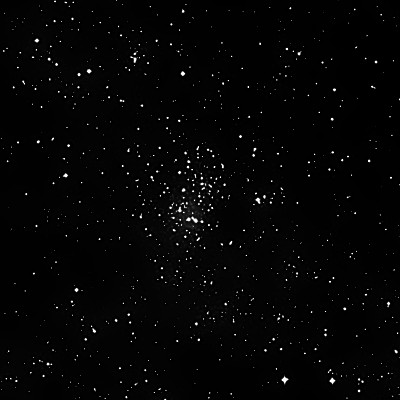
James Dunlop discovered NGC 6318 = D 522 = h3672 on 13 May 1826 and described "an exceedingly faint nebula, about 1.5' long and 1' broad, elliptical in the direction of the meridian, with two or three very small stars in it.". Dunlop made 4 observations and his published position is 18' too far east. JH observed the cluster on 5 Jun 1834 and wrote "cluster VII class. Rich, pL, R, gbM, stars 12...14th mag, not a globular." He gave a very approximate position (nearest minute +/- in RA and arcmin of Dec). In the GC, JH improved the position, but it is still 1.5 minutes of time too large. Gösta Lynga (open cluster catalogue) and NGC 2000.0 repeat the erroneous NGC position.
300/350mm - 13.1" (7/27/84): large, fairly rich group of stars mag 11 and fainter, fairly prominent, elongated N-S. The NGC RA is 1.6 tmin too far east and this cluster is misplotted on U2000.
Notes by Steve Gottlieb
NGC 6337
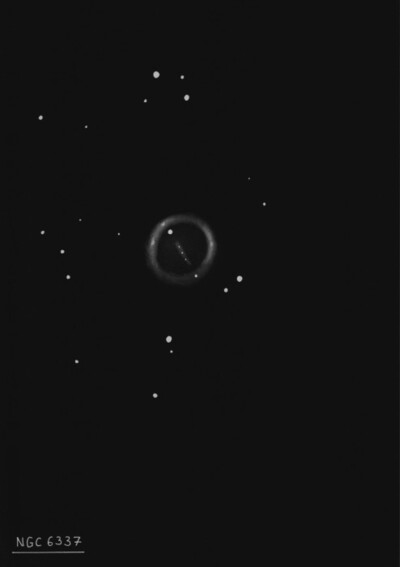
John Herschel discovered NGC 6337 = h3680 on 28 Jun 1834 and recorded an "Annular Nebula. A delicate, eF, but perfectly well defined annulus 15-20" diameter. The field crowded with stars, two of which are on the nebula (see figure 3, Plate VI.)" A later observation records "A beautiful delicate ring, of a faint ghost-like appearance, about 40" diameter; in a field of about 150 stars, 11 and 12 mag and under. In it is one *12 mag very conspicuous, and one 15 mag much less so. Near it are two stars 14 and 15 mag, and south of it at distance 60" is another."
Using his 48-inch from Malta, William Lassell also sketched a thin, perfectly symmetric ring with a star "perhaps 10.5 or 11 magnitude" on the north side and a faint one embedded on the south rim. Joseph Turner made a similar sketch in 1874 with the 48-inch Great Melbourne Telescope (plate VII, figure 75, unpublished) as well as Pietro Baracchi in Sept. 1884 with the GMT.
The 5 superimposed stars were described in the 1921 Helwan Observatory list (based on photos taken in 1914-16) as follows: "Along a diameter of the ring in p.a. 25° is a line of stars, so straight as to suggest some connection with the nebula rather than a chance superposition. The two brightest stars are at opposite ends of this line, that to the north being just inside the ring and the south one on the ring itself. Between the central star and this south star is first (distant 5" from the former) a star 17-18 mag, and then either a still fainter star or possibly a small piece of nebulosity."
300/350mm - 13.1" (5/30/87): at 166x with a UHC filter appears fairly faint, fairly small, roundish. Slightly darker center (annular) with averted vision although the contrast with the rim is low due to the elevation. No central star seen.
13.1" (7/5/83): at 144x-166x appears fairly small, faint but fairly easy, darker center (annular), somewhat like a smaller and dimmer version of M57.
400/500mm - 17.5" (6/30/00): very pretty annular planetary at 280x, ~45" and set in a rich star field. A mag 12 star is superimposed on the inner edge of the NE rim and an extremely faint star is symmetrically placed at the SW edge. The darker hole is 20"-25" diameter and perfectly circular. The outer rim appears irregularly lit.
Notes by Steve Gottlieb
NGC 6334
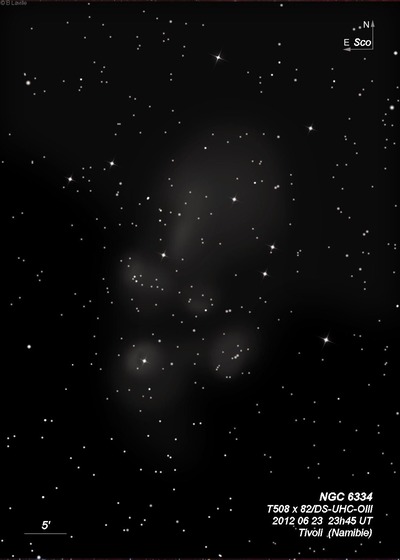
John Herschel discovered NGC 6334 = h3678 on 7 Jun 1837 and recorded "pB; vL, v irr oval, in which, though eccentric is a *8, whose place is that taken. One side of the neb is brighter than the other." The next night he called this nebula "vF; vL; vglbM; 5'x4', out of M is a *8.9 or 9 mag, whose place is taken. The densest part of the nebula follows this star 4.5 sec on the same parallel."
Massive HII region/molecular cloud complex with five distinct centers of massive star formation.
The nickname "Cat's Paw" apparently is from astrophotographer Jerry Lodriguss. He writes "I believe that I was also the one who actually gave the "Cat's Paw" nebula its popular name. I started calling it that because of its resemblance to, of all things, a cat's paw (!), and because of its proximity to the "Cat's Eyes", Lambda and Upsilon Scorpii. I think the name was first published in an article I wrote in Sky and Telescope magazine in August of 1998, and documented in Hartmut Frommert's "A Collection of Some Common Names for Deep Sky Objects" on the SEDS web site."
300/350mm - 13.1" (7/5/83): fairly easy nebulosity surrounds mag 8 star with UHC filter and extends 30' N. This is an unusually large nebulosity, mostly visible surrounding stars and includes a close faint triple star.
400/500mm - 18" (7/17/07): The "Cat's Paw Nebula" is a fascinating HII complex and molecular cloud (RCW 17) with several distinct sections. At 73x and OIII or UHC filter, the brightest section or toe is on the southeast side (NGC 6334 = Gum 62) and consists of a 4'-5' glow extending mostly north of a mag 8.5 star (HD 156738) at 17 20.9 -36 04 (2000). The nebulosity appears weaker on the SW side of the star and slightly brighter wrapping around the eastern side of the star. John Herschel only described this section of the entire RCW 127 complex.
A second large section or toe forming the southwest component (VdBH 86 = Gum 61) lies 13' to the west and consists of a faint, 5' glow involving a 17" pair (HD 319703 at 17 19.8 -36 06). This piece is asymmetric and appears as a broad fan sweeping north to SE from the central stars and is very weak or nonexistent to the SW of the stars.
A group of smaller pieces forming the northeast toe (Gum 64b) is 12'-15' N of the brighter SE section. First is an obvious 2' glow surrounding a mag 10 star (HD 319702 at 17 20.8 -35 52. A small, faint knot of nebulosity lies 3' W, no more than 1' in diameter. This knot is also situated 2' SSE of a mag 9.5 star that is free from nebulosity. But to the NW of this star another few arc minutes is a third detached piece of nebulosity (brightest part of Gum 64c), ~2' in diameter. Very weak nebulosity appears to connect the NE section (Gum 64b) with the SE section (Gum 62).
Finally, midway between Gum 64b and Gum 61 a small extremely faint detached glow (Gum 64a) was glimpsed close SE of a mag 11 star at 17 20.1 -35 57.
Notes by Steve Gottlieb
NGC 6357
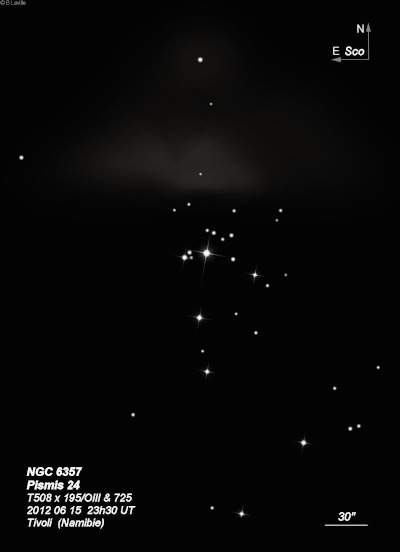
John Herschel discovered NGC 6357 = h3682 on 8 Jun 1837 and recorded "F; L; E; vglbM; milky nebulosity; 2' l; 1 1/2' br; close to and almost involves a double star." His position is on the double star mentioned in my observation.
400/500mm - 17.5" (5/30/92): at 82x using an OIII filter, this emission nebula is a bright, distinctive object, elongated 3:1 E-W, 4.0'x1.5'. A close mag 11/12 double star is at the south edge. The whole field appears weakly nebulous and the nebulosity is just very faintly visible without a filter at 220x. Excellent contrast gain with the OIII filter! A group of a dozen faint stars is just south (= Pismis 24) including a double star. This nebula is associated with the Wolf-Rayet star HD 157504 = WR 93, which is located east of the bright section.
Notes by Steve Gottlieb
NGC 6322
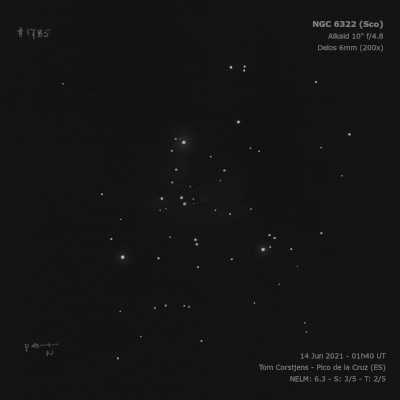
John Herschel discovered NGC 6322 = h3673 on 1 Jun 1834 and recorded "vl cl VII. class, of loose st, on a v rich ground of S stars. The chief *, 6m, at the nf edge taken. The next sweep 2 nights later he logged "Coarse B cluster VII mainly included within an equilateral triangle formed by 3 B stars 5 and 6m. The nf of these taken."
200/250mm - 8" (7/16/82): consists of a near equilateral triangle of mag 7.5, 7.6 and 7.8 stars (sides ~7') with roughly 12 faint stars scattered nearby, moderately large.
300/350mm - 14" (4/5/16 - Coonabarabran, 73x and 178x): very distinctive, eye-catching cluster outlined by a very bright equilateral triangle (sides, 6', 6', 7') consisting of mag 7.6 HD 156189, mag 7.5 HD 156292 and mag 7.7 HD 156234. In the interior is a 34" pair of mag 9/9.5 stars, along with a 16" pair of mag 10.5 stars (both oriented roughly N-S). Another mag 9.2 star (HD 156271) is at the southeast side of the cluster. Roughly 50 stars total are resolved within a 9' region, including a number of mag 12-14 stars in addition to the prominent ones mentioned.
Notes by Steve Gottlieb
NGC 6425
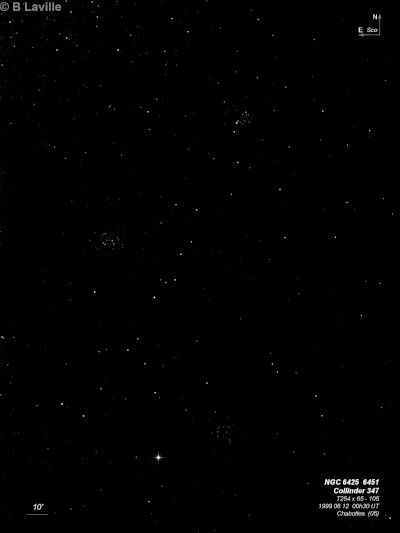
John Herschel discovered NGC 6425 = h3703 on 3 Aug 1834 and recorded "Small cl VIII class; 8' dia; has 20 or 30 st 10...12, nearly insulated." His position is good.
200/250mm - 8" (6/27/81): 15 stars mag 11-13 in a triangular outline.
400/500mm - 17.5" (8/2/97): roughly three dozen stars in a 16'x7' detached region about 20 of which are mag 11 and the remainder mag 12-13.5. The group stands out well using a 14mm UltraWide, although the stars are fairly scattered with no dense regions. Near the center is a nice 30" equilateral triangle (brightest of the trio is at the SE vertex) of mag 10.5-11.5 stars. Following this triangle is a large "hole" in the cluster devoid of any stars. The brighter stars form an irregular border although there are two noticeable strings of stars in the cluster. Located 1.5 degrees NE of M6.
Notes by Steve Gottlieb
NGC 6396
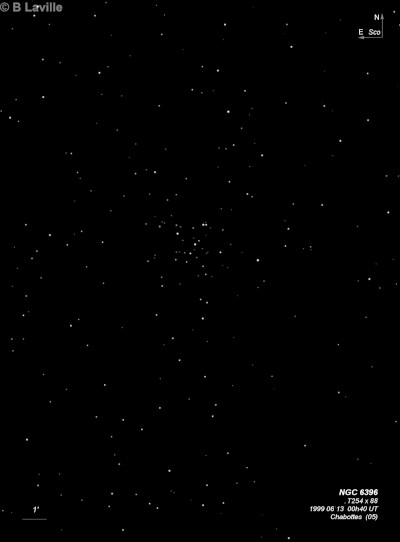
John Herschel discovered NGC 6396 = h3693 on 7 Jul 1836 and recorded "Cluster VIII; small, 5', place of chief D star". His position is 35 seconds east of the double star at the northwest side of the cluster, and well outside the confines of the cluster. Herschel's poor RA is used in the RNGC, NGC 2000.0 and the Sky Catalogue 2000.0. The ESO and Uranometria 2000.0 Atlas position is correct.
400/500mm - 17.5" (6/8/91): consists of a dozen mag 9-13 stars in a small group of 4' diameter. Includes four stars in a distinctive 2' string oriented NNW-SSE and continuing north a pretty double star (h4966 = 9.8/10.8 at 12") which is oriented E-W. The brightest star mag 9 SAO 209043 is just off the WSW edge 4' from the center. Not rich or impressive but stands out well. Also a large scattered group of fairly bright stars is roughly 20' to the north.
Notes by Steve Gottlieb
IC 4599
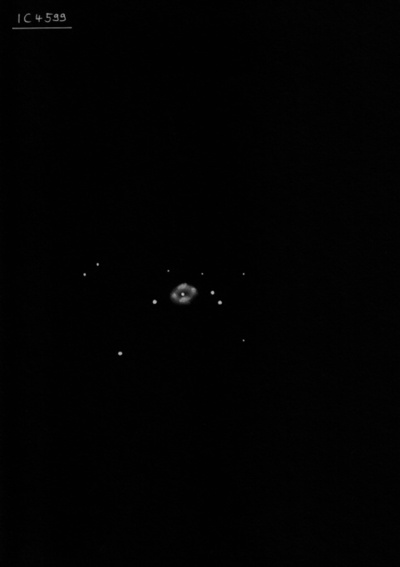
Royal H. Frost discovered IC 4599 = F. 1144 on a plate taken on 20 Jun 1903 with the 24-inch Bruce photographic refractor at Harvard's Arequipa station. He noted "Planetary, magn. about 15." Kohoutek's "Catalogue of Galactic Planetary Nebulae" (CGPN) doesn't label PK 338+5.1 as IC 4599.
300/350mm - 13.1" (3/17/86): at 79x appears as an out of focus star with an estimated V magnitude of 12.5-13.0. Considerable contrast gain with an OIII filter. Forms the northern vertex of a triangle with a mag 11 star 2.5' SSW and a mag 10 star 2.7' SE. The planetary appears fainter than the two stars unfiltered but much brighter with a filter. A small disc is clearly visible at 166x or higher. Identified as He 2-155 in CGPN and ESO-Strausberg catalogues.
Notes by Steve Gottlieb
IC 4637
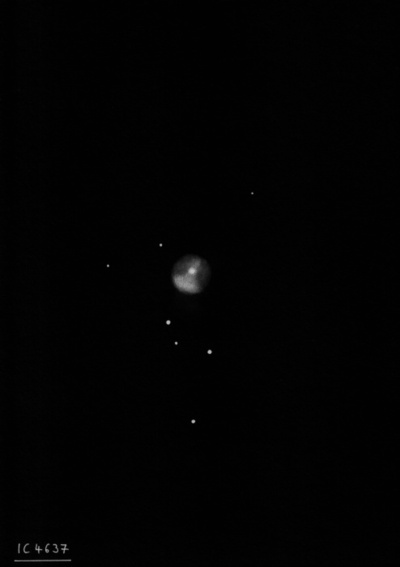
Williamina Fleming discovered IC 4637 = Fleming 96 in 1901 on a Harvard objective prism plate taken at the Arequipa station.
300/350mm - 13.1" (4/10/86): at 166x, fairly bright, small, about 15" diameter, estimate V = 12.0. At 214x the mag 13 central star is visible in good moments, otherwise the planetary has a brighter center. The disc can be resolved at 79x. Located 13' N of mag 8 SAO 227611.
Notes by Steve Gottlieb
IC 4663
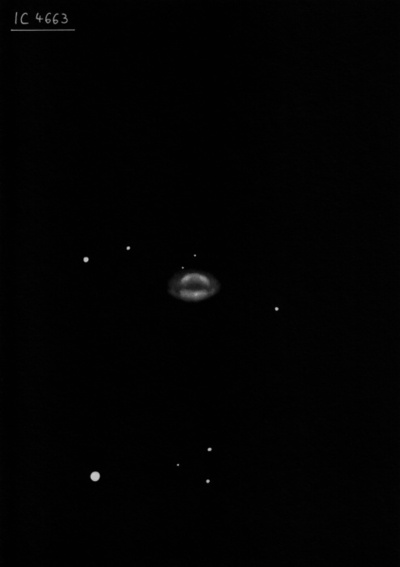
Williamina Fleming discovered IC 4663 = Fleming 97 in 1901 on a Harvard objective prism plate taken at the Arequipa station.
300/350mm - 13.1" (7/12/86): at 166x a nice disc about 15" diameter is clearly visible. Appears brighter than planetary Hb 4 by half a magnitude, estimate V = 12.5. Easily takes 214x power and a mag 13 star is visible 45" ENE of center. Located 17' N of double star h4973 = 8.3/9.1 at 13.1". Very far south for viewing from Northern California.
Notes by Steve Gottlieb
IC 4628
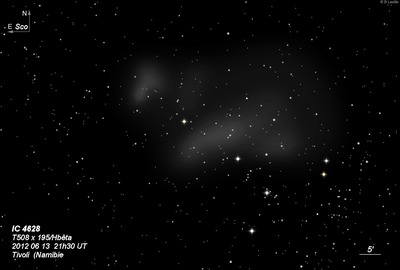
E.E. Barnard discovered IC 4628 between 1892 and 1895 on a plate taken at Lick Observatory. In Lick Publications Vol 11, 1913, Plate 37 he describes: "The coarse cluster in 16h 48m, -40.3° does not seem to be in Dreyer's lists. It is a very interesting object and appears to be connected by a scattering chain of stars, with the cluster [NGC] 6231 south of it. In its northern part is the nebula IC 4628. This was originally discovered on a plate with the Willard lens, but no announcement was made of it. It is a large nebula one half degree in diameter and of irregular form and brightness. A photograph with the 10-inch Bruce telescope at Mount Wilson in 1905 (June 21) shows the irregular group of stars and the nebula very beautifully. There are still fainter portions that extend half a degree to the northeast. The nebulosity, apparently, does not condense about any one of the stars and is probably not actually connected with the cluster." Royal Harwood Frost also found IC 4628 = F. 1148 on a photographic place taken in 1903 at Harvard's Arequipa station and both are credited in the IC.
200/250mm - 8" (7/13/91 - Southern Baja): this is an emission nebula on the north side of a large open cluster Tr 24 = H12. Appears fairly faint, very large, about 30'x10' diameter and clearly elongated E-W. Shows up best with the UHC filter at 83x although visible without a filter. Includes some brighter portions. Also visible in the 16x80 finder with a UHC filter.
400/500mm - 18" (6/12/10): this large HII region is embedded in the northern half of Tr 24, a sprawling 60' cluster just north of NGC 6231. At 108x and UHC filter IC 4628 stood out as a very large, fairly bright glow within Tr 24. The main glow was elongated E-W, roughly 30'x12' with mag 7.2 HD 152723 just off the south side. The northern side has a fairly well-defined edge and a number of mag 8-10 stars are embedded along the southwest and west end of the nebulosity. A fainter extension begins on the east end and extends northeast for ~15', ending in a brighter HII patch (G345.31+01.47) peppered with several stars and involving the infrared cluster [DBS2003] 114.
Notes by Steve Gottlieb
NGC 6178
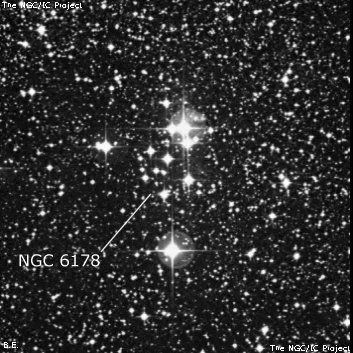
John Herschel discovered NGC 6178 = h3638 on 27 Jul 1834 and noted "middle of a small group of pB stars." On a later sweep (20 Apr 1836) he recorded "Chief * 9m of a small, bright clustering group of from 12 to 20 pL stars, with stragglers." His position is accurate.
400/500mm - 17.5" (7/4/86): about 15 stars in a triangular outline with mag 8 SAO 226939 at the NW vertex and similar star (SAO 226941) at the south vertex. A 10th magnitude star marks the NE vertex. Fainter stars mag 10-14 are inside the triangle. Appears fairly distinctive in the field.
Notes by Steve Gottlieb
NGC 6249
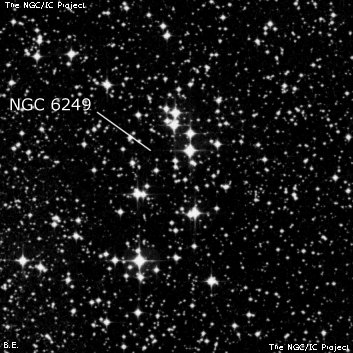
John Herschel discovered NGC 6249 = h3655 = D 455? on 1 Jun 1834 and recorded "cluster VIII class, coarse, p rich, stars 9...12m." On a second sweep (27 Jul 1834) he logged it as "VII class, p rich, loose irreg fig; large and small stars, 9...15m; 10' long, 7' broad."
James Dunlop may have been the first to find this cluster on 31 Jul 1826 with his 9-inch homemade reflector from Parramatta NSW, and described D 455 as "an extremely faint ill-defined nebula, easily resolvable into stars; this is in the milky way." His position, though is just over 40' WSW of the cluster, so the identification is very uncertain.
300/350mm - 14" (4/5/16 - Coonabarabran, 145x and 178x): bright, moderately large cluster with ~50 stars mag 10 to 14 scattered over a 7' region. Many of the stars are arranged roughly in a "C" or horseshoe shape open to the east. The most prominent part includes 4 mag 10-11 stars in a small trapezoidal shape (parallel sides N-S). Three additional mag 10-11 stars are spread out south of this trapezoid; the northern one is a 10" pair and several additional pairs caught my eye. NGC 6259, a showpiece cluster, lies 33' NE.
Notes by Steve Gottlieb
NGC 6400

James Dunlop discovered NGC 6400 = D 568 = h3696 on 13 May 1826 and described "a very faint cluster of very small stars, resembling faint nebula; the stars are considerably congregated to the centre, irregular round figure." Dunlop observed the cluster 3 times and his position is only a couple of arc minutes too far south. John Herschel observed the cluster on 28 Jun 1834 and recorded "Cluster class VII, p rich; pL, irr R, 8', stars 9..10m." His position is 0.6 minutes of time too small. The RNGC position is 0.6 minutes too far east.
200/250mm - 8" (6/27/81): faint, fairly small, fairly rich. Many stars are aligned in rows.
400/500mm - 17.5" (6/30/00): ~50 stars are resolved in an 8'x5' region at 220x. The stars are fairly uniform in brightness, though irregular in outline. The cluster is elongated N-S with a nice string extending through the cluster to the SSE and NNE with a slight bend near the center. At the kink in the center of the string is a denser clump of stars. There are circular voids on the NW and SW ends. The two brighter strings (on the following side) and two less distinct rows of stars create a vague "X" shape through the cluster with a loop of stars on the north end.
Notes by Steve Gottlieb
NGC 6268
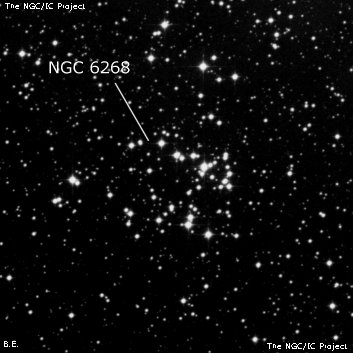
James Dunlop discovered NGC 6268 = D 521 = h3662 on 5 Jun 1826 and described "2 rows or lines of pretty bright small stars in the parallel of the equator, with a multitude of minute stars resembling a faint nebula, 5' diameter." He made 2 observations and his published position is just 2.5' northwest of center of the cluster. On 3 Jun 1834, John Herschel recorded a "cluster, rich, pL, brilliant, 8', stars irregularly scattered 10..12th mag, place of a double star in the following angle of a triangular condensed group."
200/250mm - 8" (6/27/81): 30-40 stars mag 10-12.5 in a 10' diameter. A denser group of stars in the center is arranged in a line.
Notes by Steve Gottlieb
